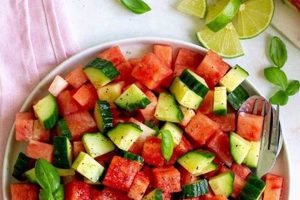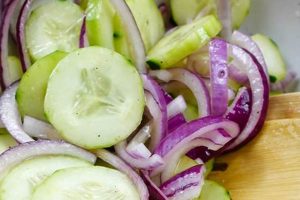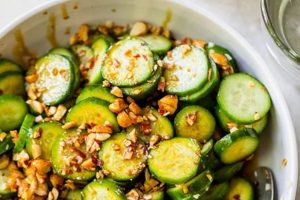A refreshing and flavorful dish, typically comprised of thinly sliced cucumbers, crumbled feta cheese, and a vinaigrette. Variations may include other ingredients such as red onion, tomatoes, olives, herbs like dill or mint, and spices. The vinaigrette often consists of olive oil, lemon juice or vinegar, salt, and pepper.
This simple salad offers a combination of textures and tastes, from the cool crispness of the cucumbers to the salty tang of the feta. It is a versatile dish, serving as a light lunch, a side dish at a barbecue, or part of a larger Mediterranean-inspired meal. Its popularity stems from its ease of preparation, affordability, and nutritional value, being a good source of vitamins and antioxidants. Historically, cucumbers and feta have been dietary staples in Mediterranean regions for centuries, and their combination in a salad reflects this culinary heritage.
The following sections will explore variations on this classic dish, offering detailed instructions for preparation, tips for ingredient selection, and suggestions for complementary pairings.
Tips for a Superior Cucumber and Feta Salad
Elevating a simple cucumber and feta salad involves attention to detail and an understanding of flavor pairings. The following tips offer guidance for creating a truly exceptional dish.
Tip 1: Salt the Cucumbers: Salting the sliced cucumbers for 15-20 minutes before adding them to the salad draws out excess moisture, preventing a watery final product and concentrating their flavor.
Tip 2: Choose High-Quality Feta: Opt for feta packed in brine, as it retains better moisture and a creamier texture. Consider exploring varieties made from sheep’s milk or a blend of sheep and goat’s milk for richer flavor profiles.
Tip 3: Balance the Vinaigrette: Achieve a harmonious balance between acidity and richness in the vinaigrette. Taste and adjust the ratio of lemon juice or vinegar to olive oil until a pleasant tang is achieved without being overly sharp.
Tip 4: Embrace Fresh Herbs: Incorporating fresh herbs elevates the salad’s aroma and complexity. Dill, mint, and parsley complement the cucumber and feta beautifully.
Tip 5: Consider Textural Variety: Adding thinly sliced red onion introduces a subtle bite, while Kalamata olives or chopped walnuts provide satisfying texture.
Tip 6: Chill Before Serving: Chilling the salad for at least 30 minutes allows the flavors to meld and enhances the refreshing qualities of the dish.
Tip 7: Season Judiciously: Freshly ground black pepper adds a touch of spice. Start with a small amount and adjust according to preference.
By following these tips, one can transform a basic cucumber and feta salad into a culinary delight. Attention to these details ensures optimal flavor, texture, and overall enjoyment.
These refinements ensure a satisfying and flavorful experience. The following section will provide variations on this classic dish, expanding its versatility.
1. Fresh Cucumbers
Fresh cucumbers serve as the foundational ingredient, providing the cool, crisp texture and mild, refreshing flavor that defines this salad. Their quality significantly impacts the overall dish, influencing both taste and aesthetic appeal.
- Variety Selection
Different cucumber varieties offer unique characteristics. English cucumbers, known for their thin skin and minimal seeds, require less preparation. Persian cucumbers offer a sweeter, less watery profile. Garden cucumbers, the most common variety, benefit from salting to reduce water content. Choosing the right variety contributes to the desired texture and flavor profile of the salad.
- Indicators of Freshness
Firmness, vibrant green color, and an absence of blemishes signify freshness. Avoiding cucumbers with soft spots or yellowing ensures optimal flavor and crispness. Freshly picked cucumbers contribute a brighter, cleaner taste to the salad.
- Preparation Techniques
Proper preparation enhances the cucumber’s contribution to the salad. Thinly slicing ensures even distribution of flavor and a pleasant texture. Salting and draining excess moisture prevent a watery salad and concentrate the cucumber’s flavor. Techniques like scoring the cucumber before slicing can add visual appeal.
- Flavor Pairing
The cucumber’s mild flavor provides a canvas for other ingredients. It complements the salty tang of feta cheese and harmonizes with acidic vinaigrettes. The cucumber’s inherent freshness balances richer components like olives or nuts, creating a well-rounded flavor profile.
The selection, preparation, and inherent qualities of fresh cucumbers directly influence the overall success of the cucumber and feta salad. Prioritizing freshness and employing appropriate techniques elevates this simple dish from palatable to exceptional.
2. Quality Feta Cheese
Feta cheese, a brined, curd cheese traditionally made from sheep’s milk or a mixture of sheep and goat’s milk, plays a crucial role in a cucumber salad with feta cheese recipe. Its quality significantly influences the overall flavor profile, texture, and enjoyment of the dish. Selecting appropriate feta enhances the balance of flavors and elevates the salad from simple to exceptional.
- Milk Source and Authenticity
Authentic feta, originating from specific regions, adheres to traditional production methods and utilizes sheep’s milk or a blend of sheep and goat’s milk. Cow’s milk feta, though available, often lacks the characteristic tangy and slightly salty flavor profile of true feta. The milk source directly impacts the cheese’s texture, ranging from creamy to crumbly, and influences its interaction with the other salad components. Choosing authentic feta contributes to a more complex and satisfying culinary experience.
- Brine Preservation
Feta is typically stored in brine, which preserves its freshness and maintains its characteristic moist, crumbly texture. Brine concentration affects the saltiness of the cheese. Opting for feta packed in brine ensures optimal texture and flavor. Rinsing the feta before adding it to the salad helps control saltiness and prevents overwhelming the delicate cucumber flavor.
- Texture and Crumbliness
Feta’s texture contributes significantly to the salad’s overall sensory experience. High-quality feta exhibits a pleasant crumbliness, allowing it to distribute evenly throughout the salad while maintaining distinct pockets of flavor. Excessive dryness or hardness detracts from the desired mouthfeel. The interplay between the creamy feta and crisp cucumber creates a textural contrast that enhances enjoyment.
- Flavor Profile and Intensity
Feta offers a unique salty, tangy, and slightly acidic flavor profile that complements the refreshing cucumber. The intensity of these flavors varies depending on factors like milk source, aging, and brine concentration. Selecting feta with a balanced flavor profile that enhances, rather than overwhelms, the other ingredients creates a harmonious and well-rounded salad.
The careful selection of high-quality feta cheese significantly elevates a cucumber and feta salad. Considering factors such as milk source, brine preservation, texture, and flavor intensity ensures a balanced and enjoyable culinary experience. Authentic feta, stored properly and exhibiting the desired crumbliness and flavor, complements the fresh cucumber and other ingredients, resulting in a more complex and satisfying dish.
3. Vinaigrette
Vinaigrette serves as the unifying element in a cucumber salad with feta cheese recipe, binding the individual ingredients and contributing significantly to the overall flavor profile. Its composition and balance directly impact the final dish, transforming separate components into a cohesive and palatable culinary experience. The vinaigrette’s role extends beyond simply dressing the salad; it enhances the flavors of the cucumbers and feta, creating a synergistic combination.
A classic vinaigrette typically consists of an acidic element, such as lemon juice or vinegar, emulsified with oil, often olive oil. This balance of acidity and richness is crucial. Too much acidity can overpower the delicate flavors of the cucumber and feta, while insufficient acidity results in a bland and uninspired salad. The quality of the oil also plays a significant role, impacting both flavor and texture. Extra virgin olive oil contributes a fruity and peppery note, while lighter oils offer a more neutral flavor profile. Herbs and spices can be incorporated into the vinaigrette, adding layers of complexity and complementing the primary ingredients. For example, a dill and lemon vinaigrette enhances the inherent flavors of both cucumber and feta, while a red wine vinaigrette offers a more robust and tangy counterpoint.
The practical significance of understanding the vinaigrette’s role is paramount. A well-crafted vinaigrette elevates the cucumber and feta salad, transforming it from a simple combination of ingredients into a harmonious dish. Careful consideration of the acid-to-oil ratio, ingredient quality, and complementary flavors ensures a balanced and enjoyable culinary experience. Furthermore, adjusting the vinaigrette allows for customization based on personal preferences and dietary considerations. Reducing the oil content creates a lighter dressing, while incorporating sweeteners like honey or maple syrup adds a touch of sweetness. Mastering the art of vinaigrette preparation is essential for creating a truly exceptional cucumber and feta salad.
4. Optional additions
Optional additions represent an opportunity to personalize and enhance the fundamental cucumber salad with feta cheese recipe. These additions introduce complexity, textural variation, and nuanced flavors, transforming a simple dish into a culinary expression. Their strategic inclusion demonstrates an understanding of complementary ingredients and their impact on the overall sensory experience.
Several categories of optional additions contribute distinct characteristics. Fresh herbs, such as dill, mint, or parsley, introduce aromatic complexity and freshness. Red onion provides a pungent bite, balancing the creamy feta and cool cucumber. Ingredients like olives, capers, or sun-dried tomatoes contribute salty, briny, or umami notes, adding depth to the flavor profile. Toasted nuts or seeds, such as pine nuts, walnuts, or sunflower seeds, introduce textural contrast and subtle nutty flavors. Consider a salad incorporating fresh dill and thinly sliced red onion; the dill complements the cucumber and feta, while the red onion adds a subtle sharpness. Alternatively, a salad with Kalamata olives and toasted pine nuts offers a briny, salty, and texturally rich counterpoint to the core ingredients.
The practical significance of understanding the role of optional additions lies in the ability to tailor the salad to specific preferences and occasions. These additions allow for customization based on seasonal availability, dietary restrictions, and desired flavor profiles. However, judicious selection and balanced incorporation are crucial. Overcrowding the salad with too many additions can mask the delicate flavors of the cucumber and feta, resulting in a muddled and less satisfying dish. A thoughtful approach ensures that each addition complements the core ingredients and contributes to a harmonious and balanced culinary experience. The careful selection and balanced incorporation of optional additions elevates the cucumber salad with feta cheese recipe from a basic preparation to a personalized and nuanced culinary creation.
5. Preparation Method
Preparation method significantly influences the final quality and enjoyment of a cucumber salad with feta cheese recipe. A systematic approach ensures optimal flavor development, texture, and presentation. Understanding the key steps and their impact on the individual ingredients and their interaction contributes to a successful culinary outcome.
- Ingredient Preparation
Proper ingredient preparation forms the foundation of a well-executed salad. Washing and drying cucumbers removes surface contaminants and prepares them for slicing. Slicing cucumbers thinly and uniformly ensures even distribution of flavor and a pleasant texture. Salting cucumbers prior to mixing draws out excess moisture, preventing a watery salad and concentrating flavor. Crumbling feta cheese allows for even distribution and optimal integration with other ingredients.
- Vinaigrette Emulsification
Creating a stable vinaigrette emulsion is crucial for flavor distribution and textural consistency. Whisking together the acidic component (lemon juice or vinegar) and oil creates a cohesive dressing that coats the salad ingredients evenly. Proper emulsification prevents separation and ensures that each bite incorporates the desired balance of flavors.
- Combining Ingredients
The order and method of combining ingredients influence the final outcome. Gently tossing the cucumbers, feta, and other additions ensures even distribution without damaging delicate ingredients. Adding the vinaigrette just before serving prevents the salad from becoming soggy and maintains the crispness of the cucumbers.
- Chilling and Serving
Chilling the salad allows flavors to meld and enhances the refreshing qualities of the dish. Serving the salad chilled maintains its optimal texture and provides a more enjoyable sensory experience. Garnishing with fresh herbs or a sprinkle of freshly ground black pepper elevates the presentation and adds a final touch of flavor.
Careful attention to each stage of the preparation method, from ingredient handling to final presentation, contributes to the overall success of a cucumber salad with feta cheese recipe. Proper technique enhances flavor development, textural contrast, and visual appeal, ensuring a satisfying and enjoyable culinary experience.
6. Chilling Time
Chilling time plays a crucial role in the final quality and enjoyment of a cucumber salad with feta cheese recipe. This seemingly simple step significantly impacts flavor development, texture, and overall palatability. Understanding the effects of chilling and implementing appropriate techniques elevates this dish from satisfactory to exceptional.
- Flavor Melding
Chilling allows the flavors of the individual ingredients, including the cucumbers, feta cheese, and vinaigrette, to meld and harmonize. The cool temperature slows down chemical reactions, preventing volatile flavor compounds from dissipating too quickly. This allows for a more nuanced and integrated flavor profile to develop, where individual components complement each other without one overpowering the others. A minimum chilling time of 30 minutes typically suffices for noticeable flavor integration.
- Texture Enhancement
Chilling enhances the textural contrast that is characteristic of a well-made cucumber salad. The cool temperature firms the cucumbers, maintaining their crispness and preventing them from becoming soggy. Simultaneously, the chilling process allows the feta cheese to maintain its desirable crumbly texture, preventing it from becoming overly soft or greasy. This interplay of crisp cucumbers and crumbly feta creates a more satisfying sensory experience.
- Temperature and Palatability
Serving the salad chilled enhances its refreshing qualities. The cool temperature provides a welcome contrast, particularly in warmer climates or during summer months. A chilled salad is more palatable and invigorating, offering a light and refreshing culinary experience.
- Practical Considerations
Practical considerations influence the ideal chilling time. While a minimum of 30 minutes allows for noticeable flavor melding and texture enhancement, extending the chilling time up to a few hours can further intensify these effects. However, excessively long chilling times, particularly beyond 24 hours, can lead to undesirable changes in texture, such as overly soft cucumbers. Balancing chilling time with practical considerations ensures optimal quality.
Chilling time is not merely a perfunctory step but rather a crucial element in crafting a superior cucumber salad with feta cheese recipe. Understanding its impact on flavor development, texture, and palatability allows for informed decision-making regarding chilling duration. Implementing appropriate chilling techniques elevates this simple dish, maximizing enjoyment and showcasing the synergistic potential of its individual components.
7. Serving Suggestions
Serving suggestions enhance the versatility of the cucumber salad with feta cheese recipe, demonstrating its adaptability to various culinary contexts. Understanding these suggestions allows for strategic integration into diverse meal structures, maximizing the salad’s potential and complementing other dishes.
- Stand-Alone Light Meal
The salad’s refreshing qualities and balanced nutritional profile make it a suitable light meal, particularly during warmer months or for those seeking a lighter fare. Its combination of fresh vegetables, protein-rich feta, and healthy fats provides a satisfying yet not overly heavy meal option. This approach emphasizes the salad as a centerpiece, showcasing its inherent flavors and textures.
- Side Dish for Grilled Meats
The cucumber salad’s cool, crisp profile complements the richness and intensity of grilled meats, providing a refreshing counterpoint. The acidity of the vinaigrette cuts through the fattiness of grilled proteins, creating a balanced and harmonious flavor combination. Serving the salad alongside grilled lamb, chicken, or fish exemplifies this pairing, enhancing the overall dining experience.
- Component of a Larger Mediterranean Spread
The salad seamlessly integrates into a larger Mediterranean spread, complementing other dishes like hummus, pita bread, and olives. Its fresh flavors and vibrant colors contribute to a diverse and appealing table setting. This approach highlights the salad’s role within a broader culinary context, showcasing its compatibility with similar flavor profiles and ingredients.
- Part of a Buffet or Potluck
The salad’s ease of preparation and transportability make it an ideal contribution to buffets or potlucks. Its refreshing nature and broad appeal cater to diverse palates, while its simple yet elegant presentation enhances the overall spread. This application emphasizes the salad’s practicality and adaptability to communal dining settings.
Understanding these serving suggestions expands the culinary possibilities of the cucumber salad with feta cheese recipe, demonstrating its adaptability to various meal structures and dining occasions. From a light lunch to a side dish or a component within a larger spread, the salad’s versatility enhances its value and broadens its appeal.
Frequently Asked Questions
This section addresses common inquiries regarding cucumber and feta salad preparation, offering concise and informative responses.
Question 1: How can excess moisture in the salad be prevented?
Salting the sliced cucumbers for approximately 15-20 minutes before combining them with the other ingredients draws out excess water. This step is crucial for maintaining a desirable texture and preventing a watery salad.
Question 2: What type of feta cheese is recommended for optimal flavor and texture?
Feta packed in brine, preferably made from sheep’s milk or a blend of sheep and goat’s milk, is ideal. Brine-packed feta retains better moisture and offers a creamier, more authentic flavor profile.
Question 3: What is the ideal ratio of oil to acid in the vinaigrette?
A general guideline is a 3:1 ratio of oil to acid. However, the optimal balance depends on personal preference and the specific type of acid used. Tasting and adjusting the vinaigrette is recommended to achieve the desired flavor profile.
Question 4: Can this salad be prepared in advance?
While the salad can be assembled a few hours in advance, it is generally recommended to add the vinaigrette just before serving to maintain the crispness of the cucumbers and prevent the salad from becoming soggy.
Question 5: What herbs complement cucumber and feta best?
Fresh dill, mint, and parsley are classic pairings that enhance the flavors of both cucumber and feta. Other herbs, such as oregano or chives, can also be used depending on personal preference and desired flavor profile.
Question 6: How should leftover salad be stored?
Leftover salad should be stored in an airtight container in the refrigerator for up to two days. However, the texture of the cucumbers may soften slightly over time.
Addressing these frequently asked questions provides clarity on key aspects of cucumber and feta salad preparation, ensuring a successful and enjoyable culinary outcome.
For further exploration of variations and customizations, consult the following section on recipe adaptations.
Cucumber Salad with Feta Cheese Recipe
Exploration of this deceptively simple dish reveals a nuanced interplay of ingredients, techniques, and culinary traditions. From the selection of fresh cucumbers and quality feta cheese to the careful balancing of the vinaigrette and the considered inclusion of optional additions, each element contributes to the final product. Proper preparation methods, including salting the cucumbers and chilling the salad, optimize both flavor and texture. The versatility of this dish, adaptable as a light meal, a side dish, or a component within a larger spread, further underscores its enduring appeal.
Cucumber salad with feta cheese represents more than a mere recipe; it embodies a culinary philosophy that prioritizes fresh, high-quality ingredients and thoughtful preparation. Its continued popularity speaks to a timeless appreciation for simplicity, balance, and the inherent elegance of fresh, seasonal flavors. Further exploration and experimentation with ingredient variations and serving suggestions promise continued culinary enjoyment and discovery.






